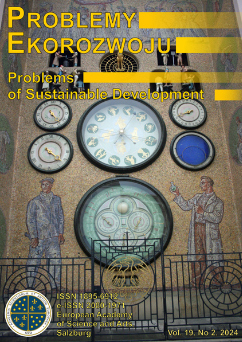Środowiskowe aspekty europejskiego doświadczenia w architekturze krajobrazu
Bao Yu
bao-yu6457@kpi.com.deHebei Normal University of Science and Technology, College of Horticulture Science and Technology, 066004, 360 West Section of Hebei Str., Haigang District, Qinhuangdao, Hebei, People’s, Republic of China (Chiny)
Jianmei Wang
Zhejiang Industry Polytechnic College, College of Architectural Engineering, 312000, 151 Qutun Road, Yuecheng District, Shaoxing City, Zhejiang, People’s Republic of China (Chiny)
Ya Li
Zhejiang Industry Polytechnic College, College of Architectural Engineering, 312000, 151 Qutun Road, Yuecheng District, Shaoxing City, Zhejiang, People’s Republic of China (Chiny)
Abstrakt
Zrozumienie wszystkich aspektów architektury krajobrazu zorientowanej na środowisko przyczyni się do efektywnego planowania środowiskowego terytorium i ogólnie do zarządzania przyrodą. W związku z tym celem badania było zbadanie doświadczeń krajów europejskich w zakresie wprowadzenia efektywnego systemu architektury krajobrazu zorientowanej na środowisko i poprawy obszarów, a także ich ochrony. W tym celu konieczne jest kompleksowe zbadanie mocnych i słabych stron istniejących rozwiązań w dziedzinie architektury krajobrazu zorientowanej na środowisko. Przeprowadzono analizę najlepszych praktyk architektury krajobrazu w takich krajach jak Wielka Brytania, Francja, Niemcy i Holandia. Wyniki pozwoliły stwierdzić, że skuteczność opracowania i wdrożenia planowania merytorycznego do projektowania krajobrazu zależy nie tylko od zakresu i głębokości badań, ale w bardzo dużym stopniu od ich racjonalnej organizacji. Stwierdzono, że w planowaniu krajobrazu zorientowanego na środowisko najpierw należy określić przyczyny planowania. Przed wyborem przedmiotu i terenu planowania należy dowiedzieć się: kim są potencjalni klienci i inwestorzy – ich cele i motywacja; jakie są sytuacje problemowe i konflikty w zarządzaniu przyrodą na danym terenie; jakie jest praktyczne wykorzystanie wyników planowania krajobrazu; cel terytorium, w tym opis kartograficzny; dostępność informacji źródłowych itp. Następnie należy podjąć decyzje dotyczące etapów planowania krajobrazowego z uwzględnieniem komponentu środowiskowego w celu odpowiedniej realizacji idei architektury krajobrazu.
Słowa kluczowe:
krajobraz, obszary naturalne, architektura krajobrazu, ekologia, ochrona środowiskaBibliografia
ANTIPOV A.N., 2005, Landscape planning: tools and application experience, Bonn, Irkutsk.
Google Scholar
ALIZADEH B., HITCHMOUGH J., 2019, A review of urban landscape adaptation to the challenge of climate change, International Journal of Climate Change Strategies and Management, 11(2): 178-194, https://doi.org/10.1108/IJCCSM-10-2017-0179.
DOI: https://doi.org/10.1108/IJCCSM-10-2017-0179
Google Scholar
BRAGA A.C.R., SERRAO-NEUMANN S., de OLIVEIRA GALVAO C., 2020,. Groundwater management in coastal areas through landscape scale planning: A systematic literature review, Environmental Management, 65(3): 321-333.
DOI: https://doi.org/10.1007/s00267-019-01244-w
Google Scholar
BRUS J., DEUTSCHER J., BAJER A., KUPEC P., OLISAROVA L., 2020, Monetary Assessment of Restored Habitats as a Support Tool for Sustainable Landscape Management in Lowland Cultural Landscapes, Sustainability, 12(4): 1-15, https://doi.org/10.3390/su12041341.
DOI: https://doi.org/10.3390/su12041341
Google Scholar
ELIZBARASHVILI N., DVALASHVILI G., SULKHANISHVILI N., 2019, Selection principles and focuses of landscape planning of protected areas, International Journal of Geoheritage and Parks, 7(1): 33-44, https://doi.org/10.1016/j.ijgeop.2019.03.003.
DOI: https://doi.org/10.1016/j.ijgeop.2019.03.003
Google Scholar
European Landscape Convention, 2000, https://rm.coe.int/1680080621.
Google Scholar
IZAKOVICOVA Z., MIKLOS L, MIKLOSOVA V., PETROVIC F., 2019, The Integrated Approach to Landscape Management – Experience from Slovakia, Sustainability, 11(17): 1-21,https://doi.org/10.3390/su11174554.
DOI: https://doi.org/10.3390/su11174554
Google Scholar
JANSSEN J., KNIPPENBERG L., 2012, From Landscape Preservation to Landscape Governance: European Experiences with Sustainable Development of Protected Landscapes, Studies on Environmental and Applied Geomorphology, 241-266.
DOI: https://doi.org/10.5772/29545
Google Scholar
KARTASHOV E., 2016, The European practice of implementing environmental strategies, Economy and State, 5: 17-19.
Google Scholar
KOLBOVSKIJ E. J., 2008, Landscape planning, Nauka, Moscow.
Google Scholar
KYVELOU S.S., GOURGIOTIS A., 2019, Landscape as connecting link of nature and culture: spatial planning policy implications in Greece, Urban Science, 3(81): 1-20, https://doi.org/10.3390/urbansci3030081.
DOI: https://doi.org/10.3390/urbansci3030081
Google Scholar
LIN L., LI M., CHEN H., LAI X., ZHU H., WANG H., 2020, Integrating landscape planning and stream quality management in mountainous watersheds: A targeted ecological planning approach for the characteristic landscapes, Ecological Indicators, 117: 1-11.
DOI: https://doi.org/10.1016/j.ecolind.2020.106557
Google Scholar
MACHAR I., 2020, Sustainable Landscape Management and Planning, Sustainability, 12(6): 1-4, https://doi.org/10.3390/su12062354.
DOI: https://doi.org/10.3390/su12062354
Google Scholar
MAKSYMENKO N.V., 2012, Landscape planning as a means of ecological landscaping, Problems of Continuing Geographical Education and Cartography, 16: 65-68.
Google Scholar
MO L., CHEN J., XIE Y., 2021, Assessment of landscape resource using the scenic beauty estimation method at compound ecological system, Environmental Science and Pollution Research, 28(5): 5892-5899.
DOI: https://doi.org/10.1007/s11356-020-10978-8
Google Scholar
NORTON B.A., EVANS K.L., WARREN P.H., 2016, Urban Biodiversity and Landscape Ecology: Patterns, Processes and Planning, Current Landscape Ecology Reports, 1: 178-192,https://doi.org/10.1007/s40823-016-0018-5.
DOI: https://doi.org/10.1007/s40823-016-0018-5
Google Scholar
PLIENINGER T., KIZOS T., BIELING C., Le DUBLAYO L., BUDNIOK M.-A., BURGI M., CRUMLEY C.L., GIROD G., HOWARD P., KOLEN J., KUEMMERLE T., MILCINSKI G., PALANG H., TROMMLER K., VERBUNG P.H., 2015, Exploring ecosystem-change and society through a landscape lens: recent progress in European landscape research, Ecology and Society, 20(2): 1-10, https://doi.org/10.5751/ES-07443-200205.
DOI: https://doi.org/10.5751/ES-07443-200205
Google Scholar
ROD'KIN O.I., ROMANOVSKIJ Ch. A., POZNJAK S.S., 2008, Environmental management, Nauka, Minsk.
Google Scholar
USTINOVA I.I., AYLIKOVA H.V., 2019, Landscape planning as ecological basis for territorial planning, Urban Planning and Spatial Planning, 70: 574-587.
DOI: https://doi.org/10.35630/978/3.00.032886.2.14
Google Scholar
WENDE W., 2019, Landscape planning and ecosystem services in Europe and beyond, Ecosystems and People, 15(1): 347-350, https://doi.org/10.1080/26395916.2019.1698278.
DOI: https://doi.org/10.1080/26395916.2019.1698278
Google Scholar
Autorzy
Bao Yubao-yu6457@kpi.com.de
Hebei Normal University of Science and Technology, College of Horticulture Science and Technology, 066004, 360 West Section of Hebei Str., Haigang District, Qinhuangdao, Hebei, People’s, Republic of China Chiny
Autorzy
Jianmei WangZhejiang Industry Polytechnic College, College of Architectural Engineering, 312000, 151 Qutun Road, Yuecheng District, Shaoxing City, Zhejiang, People’s Republic of China Chiny
Autorzy
Ya LiZhejiang Industry Polytechnic College, College of Architectural Engineering, 312000, 151 Qutun Road, Yuecheng District, Shaoxing City, Zhejiang, People’s Republic of China Chiny
Statystyki
Abstract views: 44PDF downloads: 17
Licencja

Utwór dostępny jest na licencji Creative Commons Uznanie autorstwa – Na tych samych warunkach 4.0 Miedzynarodowe.








